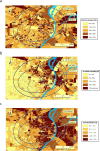The neighborhood context of homelessness
- PMID: 23409889
- PMCID: PMC3673279
- DOI: 10.2105/AJPH.2012.301007
The neighborhood context of homelessness
Abstract
Objectives: We examined and compared the changing neighborhood characteristics of a group of homeless adults over time.
Methods: We collected the addresses of previous housing and sleep locations from a longitudinal study of 400 homeless adults in the St. Louis, Missouri, region and compared census measures of housing and economic opportunities at different points along individual pathways from housing to homelessness and at 1- and 2-year follow-up interviews.
Results: Sleep locations of homeless adults were much more concentrated in the urban core at baseline than were their previous housed and follow-up locations. These core areas had higher poverty, unemployment, and rent-to-income ratios and lower median incomes.
Conclusions: The spatial concentration of homeless adults in areas with fewer opportunities and more economic and housing distress may present additional barriers to regaining stable housing and employment. A big-picture spatial and time-course viewpoint is critical for both policymakers and future homelessness researchers.
Figures



References
-
- Fitzpatrick KM, Lagory ME, Ritchey FJ. Dangerous places: exposure to violence and its mental health consequences for the homeless. Am J Orthopsychiatry. 1999;69(4):438–447 - PubMed
-
- Kushel M, Evans J, Perry S, Moss AR. No door to lock: sexual victimization in homeless and marginally housed persons. Arch Intern Med. 2002;163(20):2492–2499 - PubMed
-
- Burt M. Homeless families, singles, and others: findings from the 1996 National Survey of Homeless Assistance Providers and Clients. Housing Policy Debate. 2001;12(4):737–780
-
- Hoch C. The spatial organization of the urban homeless: a case-study of Chicago. Urban Geogr. 1991;12(2):137–154
Publication types
MeSH terms
Grants and funding
LinkOut - more resources
Full Text Sources
Other Literature Sources
Medical

